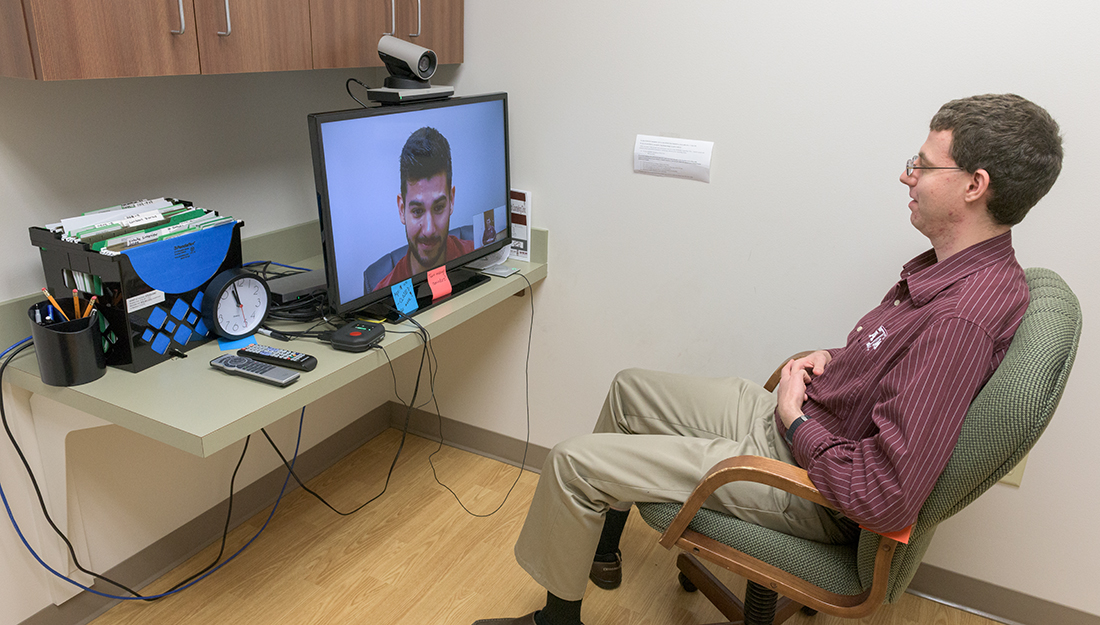- Tamim Choudhury
- Community, Public Health, Show on VR homepage
Going the extra mile: Reaching rural populations with telehealth
Telehealth Counseling Clinic utilizes technology to bring mental health care to underserved populations

Texas has one of largest rural populations in the nation, with 20 percent of its residents living in rural areas. This group tends to be older, poorer and less healthy than urban residents. Compounding the problem, they often live far away from health care providers.
The Telehealth Counseling Clinic at Texas A&M University is bringing health care to rural populations in need of mental health care through telehealth technology and serving as a platform for public health professionals to evaluate, improve, and expand telehealth technology.
Telehealth uses technology for direct service or as an adjunct to health care services. For example, video conferencing, wireless communications, remote data collection and image streaming so that health care professionals can reach patients who can’t make it to a clinic. Distance, lack of transportation, cost and a lack of providers are all mitigated by telehealth. This works especially well with chronic disease management—both physical and mental.
The Telehealth Counseling Clinic provides free telehealth counseling to residents of the Brazos Valley region, specifically Brazos, Grimes, Leon, Madison and Washington counties. With the exception of Brazos County, all of the areas served are rural. Doctoral students in psychology, under supervision of licensed psychologists, counsel those who would otherwise not receive such services. At the same time, public health experts and graduate students from the Texas A&M School of Public Health study the operation and utilize the results to make improvements to the clinic, and help others implement and improve telehealth in their own operations.
Mental health, especially in underserved communities, is a public health issue. Mental health is so intertwined with physical health outcomes, and can be a huge influence on the success of health care, as well on the cost of health care.
Because of the difficulty for rural residents to receive health care, they often go years—in some cases their entire lives—without the necessary physical and mental health services. This leaves clinicians with complex cases, requiring physicians, other health care specialists and counselors to work closely together across geographic regions.
The School of Public Health is part of the Texas A&M Health Science Center, which focuses on integrated care, with researchers and practitioners in multiple health disciplines—medicine, nursing, pharmacy, dentistry, biomedical science and public health—tasked with improving rural population health. The ultimate goal is to engage the entire team of providers—across all health disciplines—to address health disparities that exist throughout Texas.
Telehealth counseling services began in 2009 as an interdisciplinary partnership between the School of Public Health and College of Education and Human Development. This was a collaboration between Timothy Elliott, PhD, professor in the School of Public Health and College of Education and Human Development, alongside Jim Burdine, DrPH, professor in the School of Public Health’s Department of Health Promotion and Community Health Sciences. The aim was to provide telepsychology services to the underserved residents throughout the Brazos Valley. So far, this clinic has served more than 800 patients with almost 9,000 sessions, providing nearly $1 million in free counseling services to the Brazos Valley.
One of the reasons for its success is the ability to collaborate with community stakeholders like churches, missions, shelters and local clinics—in short, meeting patients where they are.
“I am trying to raise awareness of the significant disparities in the availability of services in rural areas and highlight how telehealth can help connect communities with counseling, even when providers aren’t able to physically be in rural areas,” said Carly E. McCord, PhD, a licensed psychologist, assistant professor in the School of Public Health and director of clinical services at Telehealth Counseling Clinic.
The clinic works to respond to the needs of communities, even tailoring services to meet the needs of rural residents. “We gave a workshop for people who lost a loved one, and participants started asking when the group would meet again,” she said. “The clinic’s staff members planned for a one-time event, but once they saw a need and had people who thought it would be beneficial for them, they decided to hold recurrent sessions. Some people might not want or need individual sessions but find they can get the help they need in a group setting.”
In follow-up surveys, the entire grief support group remarked that the service was as good as in-person counseling, and the telehealth service was far more convenient than a 45-minute drive to the nearest mental health provider.
Students in the program are learning to utilize technology for service delivery and exposed to the benefits of making an impact in underserved areas. The clinic provides consultation, training and online continuing education to licensed professionals and other universities, so that telehealth training can be added to their health care programs.
“We have seen hundreds of people either learn to cope better with their mental health conditions or no longer meet criteria for a mental illness all together. People have gone from homelessness to housing, re-entered the workforce, stopped inappropriately using emergency services, repaired broken relationships, improved self-esteem, stayed out of the prison system and gone on to make a positive impact in their homes, workplaces, and communities as their quality of life has improved through counseling. It is very rewarding work,” said McCord.
Media contact: media@tamu.edu


